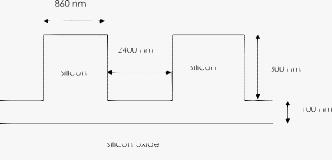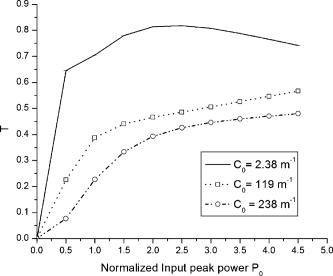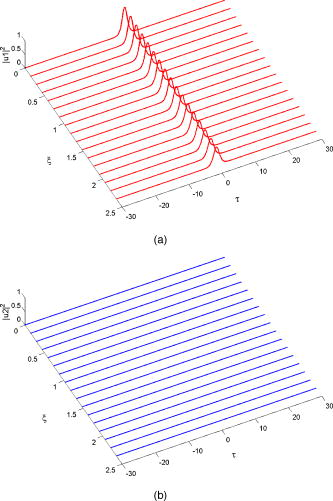|
|
|
Silicon-on-insulator (SOI) waveguides have attracted considerable attention recently because they can be used for making inexpensive, monolithically integrated optical devices.1, 2, 3, 4 The most notable features of silicon waveguides are that silicon exhibits significant third-order nonlinearity and provides a tight mode confinement. These features make it possible to realize a variety of optical functions at relatively low power level. Recently, the formation of optical solitons inside a short silicon waveguide is reported.5 Solitons have been observed inside silica fibers for a long time and found a multitude of applications ranging from optical switching to supercontinuum generation.6 In this letter, we propose, for the first time to our knowledge, a novel design of a silicon waveguide-based nonlinear directional coupler (NLDC), which can be used as a soliton self-switching device. After the pioneering work of Jensen7 and Trillo 8 silica based nonlinear directional couplers have been studied quite extensively9, 10, 11, 12, 13, 14, 15, 16, 17, 18, 19, 20, 21 in the context of soliton switching. Jensen7 showed that one can switch a continuous signal from one core to the other by varying the input power of the signal. The idea when applied to pulse switching led to pulse distortion and breakup, resulting in inefficient switching. Because the nonlinear phase modulation is proportional to the instantaneous intensity, different portions of the pulse envelope switch differently (i.e., not simultaneously), leading to pulse distortion and pulse breakup. The pulse breakup during switching is undesirable because it results in inefficient switching and causes cross talk of the signals. Trillo 8 showed that pulse breakup could be avoided if one used a soliton pulse as a signal. The physics behind it can be understood from the fact that the nonlinear phase modulation is constant across the entire soliton pulse, owing to which the pulse switches as a whole (i.e., as a single unit and no pulse breakup takes place). However, because of silica’s weak nonlinearity, extremely high power is needed for soliton switching in silica-based NLDC. This difficulty in experimental realization has left the silica-based NLDC as only a device of theoretical interest. On the other hand, silicon waveguide-based NLDC should not have this drawback because the nonlinearity parameter in the SOI waveguide can be larger by a factor of 10,000 or more.5 We expect that our proposed design for a silicon waveguide-based NLDC would draw the attention of the experimentalists working in this field. It should be noted that soliton self-switching can also be achieved by applying a different scheme in which the switching is controlled by copropagating a controlling pulse along with the signal pulse, for a detailed discussion the readers are referred to Refs. 20, 21. It is well known that the formation of fundamental soliton requires where , the dispersion length, and , the nonlinear length. It has been shown that because of high nonlinearity and tight mode confinement in SOI waveguides both and are sufficiently large to support optical solitons. Figure 1 shows our proposed NLDC. Here, two identical silicon waveguides are placed close to each other. The individual waveguides have the same dimensions as that of Zhang ’s (i.e., of ).5 The core-to-core separation distance is . The coupling coefficient can be calculated by following the prescription in Ref. 22. For our proposed NLDC, it is calculated to be . The core-to-core distance is extremely crucial in deciding the coupling coefficient of the coupler. It will be seen shortly that the coupling coefficient plays the most significant role in soliton switching in an NLDC. The switching characteristics of the coupler are described by the generalized coupled nonlinear Schrodinger equation in the anomalous dispersion regime (i.e., ), which can be derived in the framework of the coupled mode formalism, using the standard slowly varying envelope approximation,6 Here, and are the slowly varying pulse envelopes in core 1 and core 2, respectively. is the nonlinear parameter where the dimensionless parameter includes two-photon absorption. takes into account the linear scattering loss. is the second-order dispersion parameter, and is the coupling coefficient. A parameter of utmost importance in switching literature is the so-called coupling length for a coupler, which is defined as the length at which the power completely transfers from the input fiber to the other fiber. Because the set of coupled Eqs. 1, 2 is not analytically solvable, we solve them numerically by the fast Fourier transform method for the linear dispersive part and by the fourth-order Runge-Kutta method, for the nonlinear part, with autocontrol of the step size for a given accuracy of the results. We calculate the transmission coefficient , representing the fractional output energy in core 1, according to the formulaHere, and are the normalized pulse envelopes in core 1 and core 2, respectively. and are normalized distance and time, respectively. In this work, we have calculated the transmission coefficient at the end of one coupling length of the coupler. To analyze the switching process we consider the following initial conditions:We have used the following parameters for our analysis:5 , , , , , and .Figure 2 depicts the transmission characteristics of the coupler as a function of the normalized peak power for three different values of the coupling coefficients: , 119, and . These coupling coefficients can be achieved quite easily just by varying the core-to-core distance of the coupler. It can be seen from Fig. 2 that gives the best transmission. At , we get nearly 80% transmissions. As the coupling coefficient or equivalently the core-to-core separation is increased soliton switching may not be realized in our proposed device. To get an idea about the behavior and stability of the soliton pulse inside the coupler in Fig. 3, we depict the spatiotemporal evolution of the soliton pulse inside the coupler. It can clearly be seen that the soliton is preserved during evolution inside core1, while at the output of core 2 we may get a negligibly small radiation, confirming that the soliton is getting completely switched to the bar state of the coupler. It is worthwhile to mention that the peak power of the soliton required for switching in our proposed device is calculated to be , which is clearly an improvement over that of the corresponding silica based NLDC where the switching power is generally in the range of kilowatts.14, 18 ReferencesR. Soref,
“The past, present, and future of silicon photonics,”
IEEE J. Sel. Top. Quantum Electron., 12 1678
–1687
(2006). https://doi.org/10.1109/JSTQE.2006.883151 1077-260X Google Scholar
V. R. Almeida,
C. A. Barrios,
R. R. Panepucci, and
M. Lipson,
“All-optical control of light on a silicon chip,”
Nature (London), 431 1081
–1084
(2004). https://doi.org/10.1038/nature02921 0028-0836 Google Scholar
H. Rong,
R. Jones,
A. Liu,
O. Cohen,
D. Hak,
A. Fang, and
M. Paniccia,
“A continuous-wave Raman silicon laser,”
Nature (London), 433 725
–728
(2005). https://doi.org/10.1038/nature03346 0028-0836 Google Scholar
M. A. Foster,
A. C. Turner,
J. E. Sharping,
B. S. Schmidt,
M. Lipson, and
A. L. Gaeta,
“Broad-band optical parametric gain on a silicon photonic chip,”
Nature (London), 441 960
–963
(2006). https://doi.org/10.1038/nature04932 0028-0836 Google Scholar
J. Zhang,
Q. Lin,
G. Piredda,
R. W. Boyd,
G. P. Agrawal, and
P. M. Fauchet,
“Optical solitons in a silicon waveguide,”
Opt. Express, 15 7682
–7688
(2007). https://doi.org/10.1364/OE.15.007682 1094-4087 Google Scholar
G. P. Agrawal, Nonlinear Fiber Optics, 4th ed.Academic Press, Boston (2007). Google Scholar
S. M. Jensen,
“Nonlinear coherent coupler,”
IEEE J. Quantum Electron., 18 1580
–1583
(1982). https://doi.org/10.1109/JQE.1982.1071438 0018-9197 Google Scholar
S. Trillo,
S. Wabnitz,
E. M. Wright, and
G. I. Stegeman,
“Soliton switching in fiber nonlinear directional couplers,”
Opt. Lett., 13 672
–674
(1988). 0146-9592 Google Scholar
P. M. Ramos and
C. R. Paiva,
“All-optical pulse switching in twin-core fiber couplers with intermodal dispersion,”
IEEE J. Quantum Electron., 35 983
–989
(1999). https://doi.org/10.1109/3.766843 0018-9197 Google Scholar
A. Kumar and
A. K. Sarma,
“Soliton switching in a Kerr coupler with coupling constant dispersion: A variational analysis,”
Opt. Commun., 234 427
–432
(2004). https://doi.org/10.1016/j.optcom.2004.02.031 0030-4018 Google Scholar
G. I. Stegeman and
E. M. Wright,
“All-optical waveguide switching,”
Opt. Quantum Electron., 22 95
–98
(1990). https://doi.org/10.1007/BF02189947 0306-8919 Google Scholar
N. Finlayson and
G. I. Stegeman,
“Spatial switching, instabilities, and chaos in a three-waveguide nonlinear directional coupler,”
Appl. Phys. Lett., 56 2276
–2278
(1990). https://doi.org/10.1063/1.102938 0003-6951 Google Scholar
Y. Wang and
W. Wang,
“Study of ultrafast pulse coupling dynamics considering retarded nonlinear response and self-steepening effects,”
J. Lightwave Technol., 24 1041
–1047
(2006). https://doi.org/10.1109/JLT.2005.862445 0733-8724 Google Scholar
A. Kumar and
A. K. Sarma,
“Femtosecond-soliton switching in a three-core coupler,”
Jpn. J. Appl. Phys., Part 1, 44 8498
–8500
(2005). 0021-4922 Google Scholar
I. M. Skinner,
G. D. Peng,
B. A. Malomed, and
P. L. Chu,
“Soliton switching in a variable nonlinear coupler,”
Opt. Commun., 113 493
–497
(1995). https://doi.org/10.1016/0030-4018(94)00509-S 0030-4018 Google Scholar
B. A. Umarov,
F. Kh. Abdullaev, and
M. K. B. Wahiddin,
“Soliton interaction and switching in a coupler with third order dispersion and Raman effect,”
Opt. Commun., 162 340
–346
(1999). https://doi.org/10.1016/S0030-4018(99)00087-5 0030-4018 Google Scholar
B. A. Malomed,
I. M. Skinner, and
S. Tasgal,
“Solitons in a nonlinear optical coupler in the presence of the Raman effect,”
Opt. Commun., 139 247
–251
(1997). https://doi.org/10.1016/S0030-4018(97)00117-X 0030-4018 Google Scholar
A. K. Sarma and
A. Kumar,
“Phase induced soliton switching in fiber nonlinear directional couplers,”
Opt. Eng., 46
(11), 115005
(2007). https://doi.org/10.1117/1.2802081 0091-3286 Google Scholar
A. K. Sarma,
“Soliton self-switching in an asymmetric nonlinear directional coupler,”
J. Optoelectron. Adv. Mater., 11 558
–562
(2007). 1454-4164 Google Scholar
W. S. Main,
M. S. Demokan, and
H. Tam,
“All-optical routing switch using a fiber nonlinear directional coupler and controlling solitons,”
J. Lightwave Technol., 14 2793
–2798
(1996). https://doi.org/10.1109/50.545799 0733-8724 Google Scholar
N. Trivunac-Vukovic and
P. Vukovic,
“Ultrafast all-optical switching using controlling solitons and nonlinear directional coupler,”
345
–348
(1999). Google Scholar
A. W. Snyder and
J. D. Love, Optical Waveguide Theory, Chapman and Hall, London
(1983). Google Scholar
|




